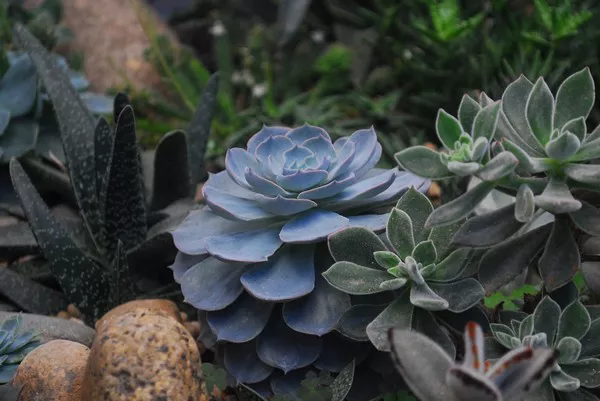Succulents are versatile and hardy plants that have captured the hearts of gardeners worldwide. Their unique shapes, striking colors, and ability to withstand various environmental conditions make them ideal for outdoor gardens. Whether you’re a seasoned gardener or just starting your green thumb journey, this comprehensive guide will provide you with valuable insights on how to maintain succulents outdoors and ensure they thrive in your garden sanctuary.
1. Choosing the Right Location
Sunlight Requirements: Succulents love sunlight and thrive in bright, indirect light or partial shade. When choosing a location for your outdoor succulent garden, look for spots with at least six hours of sunlight per day. Be cautious of intense afternoon sun, as some succulents may get sunburned.
Shelter from Extreme Weather: While succulents are resilient, extreme weather conditions can stress them. Consider placing your succulents in an area sheltered from strong winds, heavy rainfall, or frost during winter.
2. Selecting the Ideal Soil
Well-Draining Soil: Succulents abhor sitting in waterlogged soil, making well-draining soil a must. Mix equal parts of potting soil, coarse sand, and perlite or pumice to create a blend that allows excess water to escape quickly.
Soil pH: Most succulents prefer slightly acidic to neutral soil (pH 6.0 to 7.0). Test your soil’s pH and make amendments as needed to create an ideal growing environment for your plants.
3. Watering Practices
Less is More: Succulents have water-storing capabilities in their leaves and stems, making them drought-tolerant. Water your outdoor succulents sparingly, allowing the soil to dry out completely between waterings. Overwatering is a common cause of root rot and other fungal issues.
Watering Schedule: The frequency of watering depends on various factors, such as the climate, soil drainage, and succulent variety. In hot and dry climates, you may need to water more frequently, while rainy or humid regions may require less frequent watering.
Watering Techniques: When watering, aim for the base of the plant rather than directly on the leaves to prevent rot. Use a watering can or a hose with a gentle flow to avoid damaging delicate foliage.
4. Mulching and Weeding
Mulching Benefits: Applying a thin layer of organic mulch around your succulents can help retain soil moisture, regulate soil temperature, and suppress weed growth.
Choosing the Right Mulch: Opt for mulch materials such as gravel, pebbles, or crushed rock that complement the aesthetics of your succulent garden. Avoid using organic mulches, such as wood chips, as they may retain moisture and lead to root rot.
Regular Weeding: Keep your succulent garden free of weeds that can compete for nutrients and water. Handpick weeds or use a hoe to remove them carefully.
5. Fertilizing Sparingly
Nutrient Needs: Succulents are relatively low-maintenance when it comes to fertilizing. Most succulents are adapted to nutrient-poor environments and can thrive without frequent feeding.
Fertilizing Frequency: Fertilize outdoor succulents sparingly, typically once or twice a year during their active growth period in spring and summer. Choose a balanced, water-soluble fertilizer or a specialized succulent fertilizer.
6. Pruning and Grooming
Deadheading: Remove spent flowers and dead blooms to encourage continuous blooming and maintain a tidy appearance.
Trimming Leggy Growth: If your succulents start stretching and becoming leggy, prune back the long stems to encourage bushier growth.
Removing Dead or Damaged Parts: Regularly inspect your succulents for any dead or damaged parts, and carefully trim them away with clean, sharp scissors or pruning shears.
7. Pest and Disease Control
Vigilance is Key: While succulents are generally resilient to pests and diseases, it’s essential to be vigilant and inspect your plants regularly. Common pests include mealybugs, aphids, and scale insects.
Natural Solutions: For minor infestations, use natural remedies like neem oil or insecticidal soap to control pests. Avoid using chemical pesticides, as they can harm beneficial insects and disrupt the balance of your garden ecosystem.
Isolation and Treatment: If you notice any signs of pests or diseases, isolate the affected plants immediately to prevent spreading and treat them accordingly.
8. Protection from Extreme Weather
Frost Protection: If you live in an area with freezing temperatures, provide frost protection for your outdoor succulents during winter. Cover them with frost cloths or move them indoors until the cold weather passes.
Shade during Heatwaves: During heatwaves or scorching summer days, consider providing temporary shade for your succulents to prevent sunburn.
Conclusion
Creating and maintaining a thriving outdoor succulent garden can be an incredibly rewarding experience. By following the steps outlined in this comprehensive guide, you can provide your succulents with the ideal growing conditions they need to flourish in your garden sanctuary. Remember to choose the right location with adequate sunlight and shelter from extreme weather. Create a well-draining soil mix, water your succulents sparingly, and mulch to retain soil moisture and suppress weeds. Prune and groom your plants as needed, be vigilant in detecting and addressing pest and disease issues, and provide protection from harsh weather conditions when necessary. With proper care and attention, your outdoor succulent garden will become a breathtaking and enchanting display of nature’s resilience and beauty.


